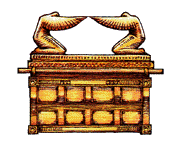The Temple at Aswan
The original Jewish
settlers at Elephantine are thought to have been Jewish
mercenaries in the pay of Egypt, who manned a garrison at
this key trading site. However, he cites one authority as
saying: "Manasseh's reign was accompanied by much bloodshed
and it may be surmised that priests as well as prophets
opposed his paganization. Some of the priests fled to Egypt,
joined the Jewish garrison at Elephantine, and there . .
. erected the Temple".7 Jewish soldiers
at Elephantine would clearly not have built a temple
there; it would certainly have required priests to have
done so. The actual evidence of these priests going to
Egypt in Manasseh's reign is not, however, given, and one
wonders why it could not have happened at the fall of Jerusalem.
Hancock argues that the
priests who went to Elephantine must have had the ark
with them, and they built a temple to house it. As stated
above, on the basis of 2 Chronicles 35:3 we do not believe
that the ark could have been taken from Jerusalem in the days
of Manasseh. It is of course possible that, when Nebuchadnezzar
took Jerusalem in 587 B.C., about sixty years later, the
ark was rescued by some priests who fled to Elephantine
with it, but Hancock does not refer to this possibility.
Next section: From Egypt to Ethiopia

